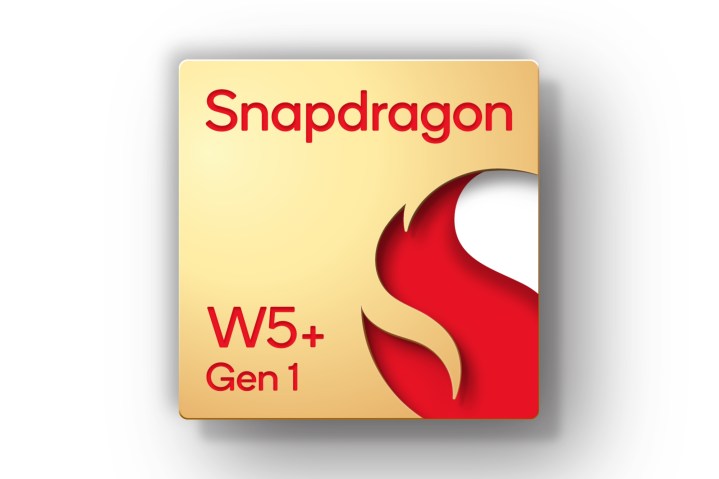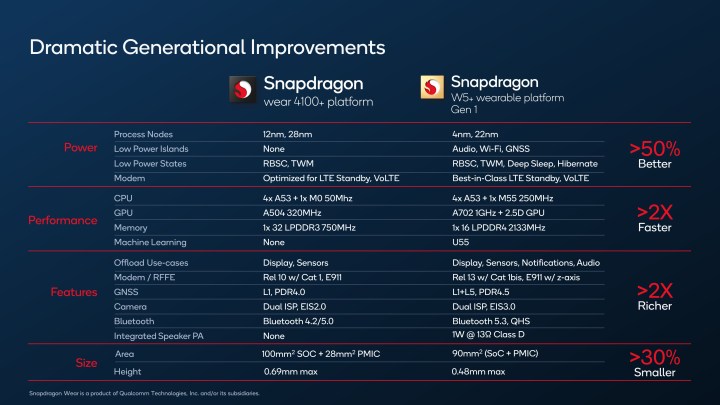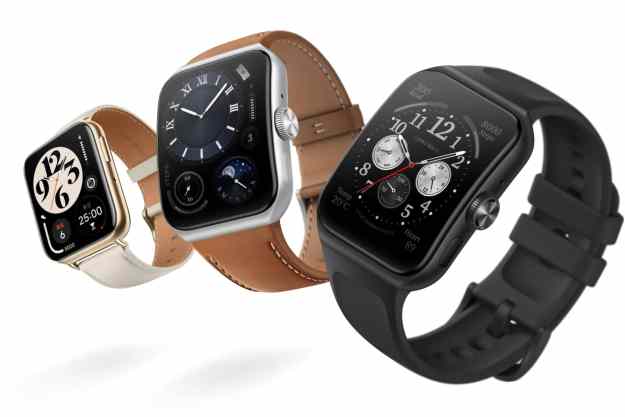Qualcomm has a new wearable chip for smartwatches. Actually, there are two of them. They’re the Qualcomm Snapdragon W5 Gen 1 and W5+ Gen 1, and Qualcomm thinks they’re the next big revolution in smartwatch chipsets.
Stop me if you’ve heard this one before. The Snapdragon Wear 3100 from 2018 was also supposed to supercharge Wear OS watches and take them to the next level. But beyond some fairly modest battery improvements, performance on the Wear 3100 left a lot to be desired. And 2020’s Wear 4100 and Wear 4100+ chips weren’t much better. Qualcomm again made some battery improvements and performance gains, but seldom few smartwatches actually adopted the 4100 platform. A handful of watches from Mobvoi and Fossil use a 4100-series chip, and that’s about it. Samsung’s Galaxy Watch lineup is using Exynos chips, and rumors even suggest Google’s Pixel Watch will do the same.

But now we have these Snapdragon W5 and W5+ chips. Similar to the Snapdragon 8 Gen 1 rebranding Qualcomm introduced for its smartphone chips last year, the old Wear brand is gone in favor of the W5 moniker. It’s a signal of how important Qualcomm thinks the W5 platform is. And based on everything the company’s shown so far, it’s a change that seems warranted.
W5+ Gen 1 vs. W5 Gen 1
Similar to the Wear 4100 series, Qualcomm is giving companies two distinct chip options to choose from: the W5+ Gen 1 and the W5 Gen 1.
In short, the W5+ Gen 1 will be the go-to chip for “mainstream smartwatches,” while the W5 Gen 1 is designed for “segment-specific wearables.” Qualcomm says this includes kid and senior-focused watches, health wearables, etc.
In an interview with Pankaj Kedia, Qualcomm’s Sr. Director and Global Head of Wearables, he told me, “Could W5 be used in [smart] glasses? Sure. Could W5 be used in a pendant without a display? Sure.” Both the W5+ Gen 1 and W5 Gen 1 support Wear OS and Android, but Qualcomm’s trying to target a wider reach of wearables with this lineup. The W5+ Gen 1 is the flagship chip for smartwatches, while the standard W5 is the catch-all for everything else.
Huge leaps in performance
This means that the W5+ Gen 1 is the chip you’ll likely see in new Wear OS smartwatches launching in the weeks and months ahead. The good news? Qualcomm’s performance and design improvements for the W5+ Gen 1 sound incredible.

The main component of the W5+ Gen 1 and W5 Gen 1 is Qualcomm’s new SW5100 SoC (system-on-chip). It’s a quad-core CPU with a 4nm design — a substantial upgrade over the 12nm Wear 4100/4100+ and 28nm Wear 3100. The smaller design of the SoC means a few things: faster performance, more efficient battery life, and smaller smartwatch designs.
On the note of performance, Qualcomm says that the W5+ Gen 1 is 2x faster compared to the Wear 4100+ from two years ago. The CPU is still a quad-core Cortex A53 chip, though it’s now joined by a Cortex M55 co-processor clocked at 250MHz. The Adreno 504 GPU from the 4100+ has also been swapped out for the Adreno 702. And instead of running at a paltry 320MHz like it was the Wear 4100+, the W5+ Gen 1 ramps up the GPU to 1GHz. You also now get 2133MHz of LPDDR4 RAM (up from 750MHz of LPDDR3) and Qualcomm’s U55 machine learning chip — something the Wear 4100+ didn’t have at all. The W5+ Gen 1 also adds a faster Wi-Fi modem, a “best-in-class” LTE modem, and upgrades the old Bluetooth 4.2/5.0 technology to Bluetooth 5.3.
Kedia told me that he “doesn’t use the phrase ‘most advanced leap yet’ casually,” but that’s clearly how Qualcomm is pushing the W5+ Gen 1.
Hours and hours of extra battery life
But performance is just part of the story. Equally important for the W5+ Gen 1 is battery life. Compared to the Wear 4100+, Qualcomm’s promising 50% longer battery in “typical DOU (day of use) scenarios.” Qualcomm outlined three examples in my briefing, and each one sounds more impressive than the one before it.
On a “sleek fashionable” smartwatch with a 300mAh battery, the W5+ Gen 1 will offer 43 hours of battery versus 28 hours on the same watch with the Wear 4100+. A “4G connected smartwatch” with a 450mAh battery will get 54 hours on the W5+ Gen 1 compared to 36 hours on the Wear 4100+. And going up to a “4G connected sports watch” with a 600mAh battery, the W5+ Gen 1 cranks out 72 hours of battery instead of 48 hours on the Wear 4100+. Those are increases of 15 hours, 18 hours, and 24 hours, respectively. And that’s all in scenarios with an always-on display enabled!
How is Qualcomm achieving such substantial battery gains after just two years? While the new 4nm SW5100 SoC helps, the secret sauce is the W5+ Gen 1’s Cortex M55 co-processor. When you’re interacting with your watch (using apps, sending messages, using a 4G LTE signal, etc.), those are all scenarios where the SW5100 kicks into gear. But if you’re not actively interacting with your watch, the co-processor now handles most everything else — including the always-on display, music, notifications, fitness tracking, sleep tracking, heart-rate monitoring, and fall detection. During these ambient times, the W5+ Gen 1 will automatically enter Qualcomm’s new Deep Sleep and Hibernate modes for drastically reduced power consumption. But when you’re ready to use an app or answer a phone call, the SW5100 SoC kicks on with all of its extra horsepower within microseconds.
A big deal for small wrists
Last but certainly not least, the W5+ Gen 1 is bringing this increased performance and battery life into a chipset that’s notably smaller than the Wear 4100+. The W5+ Gen 1’s PCB (printed circuit board) is 40% smaller, the chipset is 35% smaller, and the SoC is 30% smaller. My personal favorite metric, though, is when Kedia told me he was holding the W5+ Gen 1, dropped it on the floor, and couldn’t find it back.
While we’re talking about differences in millimeters between the Wear 4100+ and W5+ Gen 1, Qualcomm says the new chip should allow for smaller-sized smartwatches than what we have today — both in terms of case size and thickness. As someone with small wrists who often struggles to find a smartwatch that doesn’t look absolutely ridiculous on me, this excites me a lot.
Why Qualcomm says this time will be different
On paper, everything about the Snapdragon W5+ Gen 1 sounds incredible. It’s faster, has longer battery life, and is a much smaller chip than before. But why now? After years and years of disappointing Snapdragon Wear chips, why is Qualcomm now going all out with the W5+ Gen 1?

I asked Pankaj Kedia, and he said it essentially comes down to three main points. First, Qualcomm is able to invest more in its wearable efforts thanks to the growth of the entire wearable industry. “As the size of the market grows, we [Qualcomm] can afford bigger investment.” Second, Kedia said that this is something Qualcomm’s customers have been asking for. “Our customers are not shy. If they like something, they tell us. If they don’t like something, they tell us in a much louder voice.” Third — and the point which Kedia said is the most important — is that a chip like the W5+ Gen 1 simply wasn’t possible before. Whether it be the 4nm SoC, the new co-processor, or the addition of machine learning, these are all things Qualcomm couldn’t do with the Wear 4100+ (or any Snapdragon Wear chip before that).
It also seems like Qualcomm learned from its mistake of the Wear 4100+’s lacking adoption. The company’s been shipping W5 chips to customers for the past six months, and 9 times out of 10, Kedia says he’ll walk to a potential customer and walk out with a design. According to Kedia, the W5 Gen 1 platform “sells itself.” And that’s evident in today’s announcement. Oppo’s confirmed it’s launching a W5 Gen 1 smartwatch in August, while Mobvoi will launch a W5+ Gen 1 wearable later in the fall. Qualcomm’s confirmed 25 upcoming wearables with W5 chips, and it plans on announcing more soon.
While we can’t make any final say on the W5 Gen 1 and W5+ Gen 1 until we’ve actually used them, I’m more optimistic about the future of Qualcomm’s wearable division — and Wear OS by extension — than I’ve been in years. And it seems like Kedia is too. The W5 Gen 1 is “not just a chipset announcement,” he told me. Instead, it’s something that’ll “change the momentum in the industry.”
Editors' Recommendations
- Qualcomm’s newest chip will supercharge budget Android phones
- Qualcomm’s Snapdragon 4 Gen 2 brings faster 5G to budget phones
- Qualcomm’s Snapdragon X75 ushers in the next era of 5G connectivity
- At CES 2023, it’s not the software that’s killing Android smartwatches
- Using the Snapdragon 8 Gen 2 showed me that 2023 phones will be monsters




